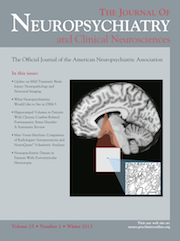Tetrabenazine and Suicidal Ideation
To the Editor: Huntington's disease (HD) is an inherited progressive neurodegenerative disorder associated with choreiform movements, psychiatric problems, and dementia. Chorea is a key feature and most times the symptom leading to the diagnosis of the disease. Chorea could also be associated with functional impairment and warrants treatment. Most commonly, it can be treated with various pharmacological measures, including typical and atypical neuroleptics, and monoamine-depleting agent such as tetrabenazine.
We report on a 52-year-old Caucasian woman presenting to the emergency department with worsening depression for the past week and new-onset suicidal ideation. Patient had a history of depression diagnosed 7 years ago and which had been under remission for the past 2 years. She was on fluoxetine 40 mg daily and mentioned good medication compliance. The patient was diagnosed with HD 3 years ago after insidious onset of chorea in the facial area and the upper extremities. The patient had been started on tetrabenazine 2 weeks ago. She was started on 12.5 mg for the first week and was later increased to 12.5 mg twice a day in the second week. The patient’s affective worsening lacked any psychosocial stressors, and she could temporally relate her condition to the addition of tetrabenazine. Fluoxetine was increased to 60 mg a day, and the patient was discharged from the emergency department with a safety plan and follow-up at the outpatient clinic. Two weeks later her depression has responded to the increase in fluoxetine, and she denied any suicidal ideations. She was continued at the same dose of tetrabenazine and follow-up at the outpatient psychiatry clinic.
Tetrabenazine acts as an inhibitor of vesicular monoamine transporter-2, leading to depletion of central dopamine, norepinephrine, and serotonin.1 Considering this mechanism of action, depression has been associated as an adverse reaction to the medication. Depression has been associated with 15% of the patients treated with this medication and seems more likely in patient with a pre-existing history of depression.2 Suicide among patients on tetrabenazine has also been reported.3,4 Fortunately, this particular medication-induced depression has been shown to respond to antidepressants.5 Hence, close follow-up and special attention to patients with a pre-existing history of depression after prescribing tetrabenazine is warranted.
1 . The pharmacokinetics of tetrabenazine and its hydroxyl metabolite in patients treated for involuntary movement disorders. Eur J Clin Pharmacol 1986; 29:703Y708Google Scholar
2 : Is history of depression a contraindication to treatment with tetrabenazine? Clin Neuropharmacol 2006; 29:259–264Crossref, Medline, Google Scholar
3
4 . Huntington disease: tetrabenazine compared to haloperidol in the reduction of involuntary movements. Neurologia 1989; 4:282Y287Google Scholar
5 : Tetrabenazine for Huntington’s chorea. BMJ 1970; 4:55Crossref, Medline, Google Scholar



